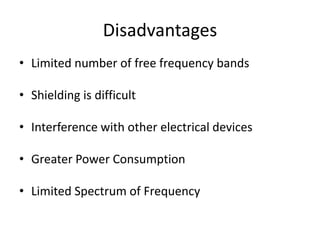Infrared and radio transmission
- 2. Infrared TransmissionInfrared (IR) light is electromagnetic radiation with a wavelength longer than that of visible light, measured from the nominal edge of visible red lightEmployed in short-range communication among computer peripherals and personal digital assistants and electronic devices
- 3. Uses infrared light-emitting diodes
- 4. Receiver uses a silicon photodiode to convert the infrared radiation to an electric current
- 5. Responds only to the rapidly pulsing signal created by the transmitter, and filters out slowly changing infrared radiation from ambient lightPropagation
- 7. AdvantagesSimple CircuitCheapLow Power ConsumptionNo Licenses NeededHigher SecuritySimple ShieldingPortable
- 8. DisadvantagesWorks ONLY on Line-of-Sight (LOS) ModeShort RangeBlocked by common materials: people, walls, etcLow bandwidthSpeed is comparatively slow
- 10. Radio TransmissionRadio is the transmission of signals through free space by modulation of electromagnetic waves with frequencies below those of visible light
- 11. PropagationRadio waves travels by means of oscillating electromagnetic fields that pass through the air and the vacuum of spaceInformation is carried by systematically changing (modulating) some property of the radiated waves, such as amplitude, frequency, phase, or pulse width
- 13. AdvantagesSimple CircuitCheapNo Licenses NeededHigh Speed/BandwidthCovers Large Areas (Penetrates through walls)
- 14. DisadvantagesLimited number of free frequency bandsShielding is difficultInterference with other electrical devicesGreater Power ConsumptionLimited Spectrum of Frequency












